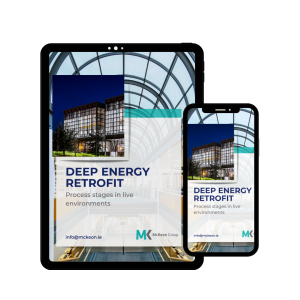Deep Energy Retrofit – Improve Energy Efficiency and Sustainability
Deep Energy Retrofit – Improve Energy Efficiency and Sustainability
06/03/2023
Implementing a deep energy retrofit for a building can provide significant economic, environmental, and social benefits to building owners, occupants, and society. This process involves upgrading various building components to increase energy efficiency, resulting in a reduced carbon footprint, energy savings, improved indoor environmental quality, increased asset value, and compliance with regulations. Among the measures typically taken during a deep energy retrofit upgrade to insulation, HVAC systems, lighting, windows, and doors, as well as the installation of renewable energy systems. Notably, this retrofitting process can be carried out in live environments, minimising disruption to occupants. McKeon Group specialises in customised solutions for deep energy retrofits and has worked with commercial, government, and educational clients to create energy-efficient, sustainable, and comfortable buildings.

Several measures are typically taken when retrofitting a building to increase energy efficiency
- Upgrading the building’s insulation:
Insulation keeps the building warm during the winter and cool during the summer, reducing the need for air conditioning and heating. Adding insulation to walls, roofs, and floors can significantly reduce a building’s energy consumption.
- Replacing or upgrading the heating, ventilation, and air conditioning (HVAC) system:
HVAC systems are responsible for a significant portion of a building’s energy consumption. Replacing an older, inefficient HVAC system with a new, energy-efficient one can result in substantial energy savings.
- Installing energy-efficient lighting:
Replacing older lighting systems with newer, more efficient LED lighting can reduce a building’s energy consumption and improve the quality of light.
- Upgrading windows and doors:
Replacing older windows and doors with newer, energy-efficient models can help reduce heat loss in the winter and heat gain in the summer.
- Installing renewable energy systems:
Installing solar panels, wind turbines, or other renewable energy systems can help a building generate energy and reduce its dependence on grid-supplied energy.
These are just some measures usually taken when retrofitting a building for energy efficiency. The actions will depend on the building’s energy usage patterns, construction type, and other factors.
Refer to the interactive image below for information on the various components of energy retrofitting
Deep energy retrofits in live environments
Deep energy retrofits are usually done in live environments, which means the retrofit can occur while the building is in use. As a construction company, we understand that deep energy retrofits can be challenging in live environments. That’s why we take a strategic and collaborative approach to ensure that the retrofit is carried out with minimal disruption to occupants.
Completed Deep Energy Retrofits
McKeon Group has completed deep energy retrofits for many clients, including the OPW, HSE, third level colleges, hospitality, food production and pharma. We specialise in creating custom solutions that meet each client’s unique needs and goals, resulting in energy-efficient, sustainable, and comfortable buildings.
Check out our work on one of these projects on UCD, Belfield District Heating System in this video or find out more about SEAI Pathfinder projects here.
Fill in the below form to download your free e-book for more information on how we implement a deep energy retrofit in live environments

Recent Posts
Sustainability in the Construction Sector and Tendering Process
As the world turns its attention towards sustainability and combating climate change, industries are re-evaluating...
Read ArticleThe Importance of a Multi-Skilled Facilities and Maintenance Services Team
As companies compete in today's fast-paced business climate, having a well-maintained, efficient, and safe working...
Read ArticleBuilding the Future with BIM
Explore how Building Information Modelling (BIM) is paving the construction industry's future with its comprehensive...
Read Article
